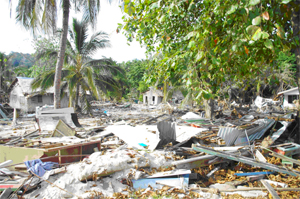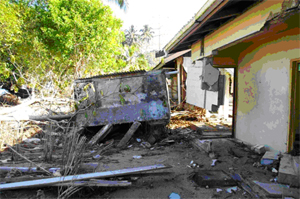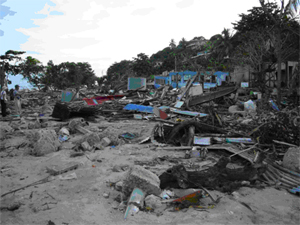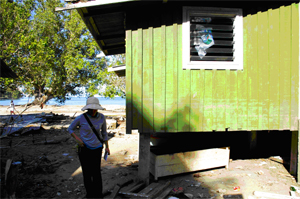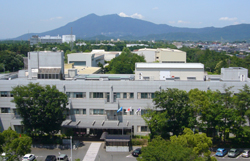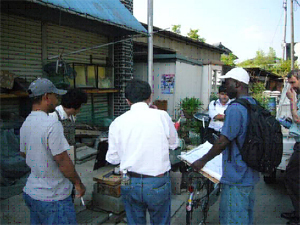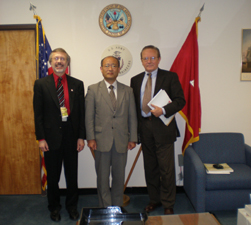| In
our periodical newsletter, we continue our focus on providing our national and
international partners and colleagues with up-to-date information on the progress
of our activities at ICHARM.
(Click here
for back numbers of UNESCO-PWRI newsletters) |
| Vol2.-No.2
Issue No.5 |
What's
in this issue |
| | PWRI Main
Building and Mt. Tsukuba
(July 2007) | - Message
from the Director
- Recent Report
- Survey on Quake/Tsunami Damage in the
Solomon Islands on 2nd April, 2007
- Research
- 5th Annual Mekong Flood Forum (Ho Chi
Minh, Vietnam; 17th-18th May, 2007)
- Flood
Hazard Map Help Desk (FHM-HD) has been launched
- Symposium
for Advances in River Engineering (Tokyo, Japan; 7th-8th June, 2007)
- Training
- Introduction of "Comprehensive Tsunami
Disaster Prevention Training Course" at UN/ISDR conference (Colombo, Sri Lanka;
25th-26th April, 2007)
- New Master's
Program: "Disaster Management Policy Program (Water-related Risk Management
Course)"
- Town Watching
Exercise (Kurihashi, Japan; 5th-8th June, 2007)
- Attended
International Event
- PIARC
Seminar (Cartagena, Colombia; 3rd-4th May, 2007)
- UNESCO
Trust Fund Review Meeting (Jakarta, Indonesia; 23rd-24th May, 2007)
- 1st
UNESCO Water Centers Directors Meeting (Delft,Netherlands; 11th-12th June, 2007)
- UNESCO-IHE
50th Anniversary Symposium (Delft, Netherlands; 13rd-15th June, 2007)
- Coming
Events
|
| |
| 1.
Message from the Director |
| |
| The first session of the Global Platform
for Disaster Risk Reduction, hosted by the United Nations International Strategy
for Disaster Reduction (UN/ISDR), was held from 5th-7th June, 2007 at the Geneva
International Conference Center in Geneva, Switzerland. It was the first follow-up
meeting on assessment of the Hyogo Framework for Action (HFA) implementation based
on the agreement concluded at the UN/ISDR conference in Kobe, January 2005. On
the first day, the Geneva Conference Center was filled with approximately 1000
participants with high expectations for positive outcomes. Mr. John Holmes, UN
Under-Secretary-General for Humanitarian Affairs, was a splendid chair and concisely
summarized the presentations and discussions on the last day of the conference. The
underlying understanding shared by all the conference participants was that adaptation
to climate change is a truly impending issue to address. The recent IPCC4 report
warns that climate change is a problem of the present, not the future. In fact,
fueled by extreme meteorological phenomena caused by climate change, water-related
disasters, now accounting for 80% of the total disasters, are increasing in number
and magnitude and demand urgent preventive measures. The conference contended
the need of a paradigm shift that disaster risk reduction must be mainstreamed
in society by firmly including it as an integral part of any development and/or
environmental conservation actions. Participants repeatedly voiced their views
concerning mainstreaming disaster risk reduction, for instance, by legislation
through strong political leadership, by institutionalization, or by implementation
of a fund allocation system by which a certain portion of a donor fund for development
is always allocated to disaster risk reduction. Chair Holmes mentioned this very
point in his Chair's Summary. This is of great significance for ICHARM, too. Coincidentally,
this issue of mainstreaming disaster risk reduction was also brought up in the
proposal, entitled "Construction of Secure and Safe Society against Global
Changes of Natural Disasters," presented by the Science Council of Japan
this past May. The proposal states first and foremost that a paradigm shift is
needed in prioritizing "structuring a safe and secure society" over
"short-term economic effectiveness" considering how to deal with natural
disasters in the future as natural environment changes and social and national
land structures become vulnerable. The Hyogo Framework clearly shows what
concrete actions we need to take. It is an action plan, not a set of retrospective
view of what people should have done in past disasters. Now is the time to put
the framework into action. Voices for mainstreaming disaster risk reduction is
nothing but a statement that entire society needs to be geared toward a disaster-conscious
one and that disaster risk reduction needs to be given a higher political priority.
To this end, we at ICHARM intend to provide convincing scientific information,
develop technologies for implementation, and train competent experts and practitioners. We
are already working on all those areas, but to be successful in them, we need
to collect data on disasters from countries and regions throughout the world,
integrate state-of-the-art technologies from different scientific fields, facilitate
good communications with local disaster-related experts and practitioners, and
provide human capacity building programs. Also, multilateral cooperation both
at home and abroad is necessary to make those activities happen. In particular,
domestic cooperation is a must, without which international cooperation cannot
exist, and is imperative for ICHARM to mainstream disaster risk reduction. We
will address the mainstreaming of disaster risk reduction in every aspect possible,
such as science, practice, human and financial resources. We therefore sincerely
ask for continued support from individuals and organizations to build and implement
stronger partnerships with us. |
| |
 Dr. Kuniyoshi
Takeuchi
Dr. Kuniyoshi
Takeuchi
Director of ICHARM |
|
|
| 2. Recent Report |
| |
| Survey on
Quake/Tsunami Damage in the Solomon Islands on April 2 ,2007 |
| | | |
|
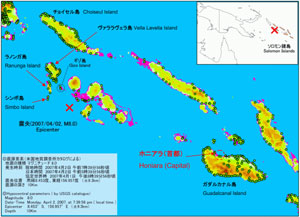
click to enlarge
A
strong quake of magnitude of 8.1 hit the Solomon Islands and the nearby areas
at 7:40 a.m. Monday, April 2, 2007. The seismic center was located just off shore
at a depth of 10 km at 8.481 South latitude and 156.978 East longitude. The islands,
especially the Western Province, suffered a magnitude of damage by a subsequent
quake-induced tsunami. The Japan International Cooperation Agency (JICA) dispatched
a project-formation survey team to assess the local needs for recovery and reconstruction
projects. Mr. Tanaka, Senior researcher, participated in this team, which stayed
on the islands from April 18th to May 2nd. The most damage occurred in Gizo
City, a city on the northern part of Ghizo Island that is located 350 km WNW of
Honiara (the capital of the Solomon Islands, which is located on Guadalcanal Island).
According to the Hokkaido University survey team, the tsunami height was about
one meter at the center of Gizo City, while it reached up to five meters in the
southern part of the island. The tsunami reached its highest, about nine meters,
when hitting Simbo Island, south-west of Ghizo Island. The tsunami height wasn't
so high at Ranunga Island, north of Simbo Island, because the island had been
lifted 2.0 m to 3.4 m due to the earthquake. The number of casualties in
the Western Province was 33 in Ghizo, 9 in Simbo, 2 in Ranunga, 2 in Vella Lavella,
and 6 in the Choiseul Province. | |
Most of the deaths were caused by the tsunami, and half of them were children.
Residents of the Western Province live along the sea coast because they generally
make a living from the sea. However, the number of dead was relatively low despite
the tsunami size; because right behind their living areas lie hills, residents
were able to quickly take refuge on higher ground before the tsunami attack. Local
people have general knowledge about tsunamis because it has been passed on from
generation to generation and is broadcasted on the radio. Some people started
evacuation when they saw the seawater recede or saw the tsunami coming in the
distance after the earthquake. In one village, all of the residents were safe
because the village leader warned them to evacuate. Also, because people in general
make a living from the ocean, they were quick to notice that something was wrong
with the seawater receding toward the offshore and were able to flee as early
as possible. It was 20 days after the tsunami disaster when the JICA survey
team visited the affected sites, but people who escaped the disaster were still
forced to camp out on the hilly areas. Seeing that the refuge sites faced problems
of food, water, and hygiene definitely reminded us that it is imperative to prepare
safe and secure evacuation sites for opportunities like this. The houses
in the affected areas look resistant to ocean-related disasters since they are
usually built in the piloti style. However, they vary in the elevation of floor
and building structure, and are actually vulnerable to such disasters as tsunamis
and storm surges, which rarely occur. It is highly likely that areas of similar
characteristics exist all around the Pacific region. It is urgently needed that
precautionary measures are taken in those areas. Related information
USGS
JICA Survey
Report
River
Bureau Report
|
| | |
|
| Titiana Village
(Ghizo Island), totally devastated by the tsunami | |
Sasamunga Village (Choiseul Island) |
| | | |
| | |
|
| Destruction seen
on the southern side of the Gizo Hospital | |
Tsunami mark can be seen at a height of the woman's head (Sasamunga, Choiseul
Island) |
| |
|
| 3.
Research |
| |
| i.
5th Annual Mekong Flood Forum (Ho Chi Minh, Vietnam; May 17-18, 2007)
|
| | | |
| The 5th Annual Mekong
Flood Forum was held on 17th - 18th May 2007 at Ho Chi Minh City in Vietnam. This
annual forum sets a certain theme to discuss and make presentations on. The theme
chosen this year was "Improving Inputs towards Medium Term Flood Forecasting and
Warning in the Mekong Basin." Dr. Takeuchi, Director, Dr. Hapurachchi, Speciality
Researcher and Mr. Inomata, Researcher in Hydrologic Engineering Research Team
attended the forum on behalf of ICHARM. Dr. Takeuchi presented on "GEOSS Initiative
and the Flood Forecasting System of the Mekong River Basin," while Dr. Hapuarachchi
presented on "Hydrologic Modeling of the Mekong River Basin Using the BTOPMC Model."
Mr. Inomata presented about ICHARM activities. ICHARM technologies and activities
were | |
successfully introduced to the people of the riparian countries in the Mekong
River Basin through our attendance and presentations.
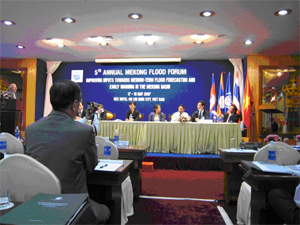 |
|
| |
| ii.
Flood Hazard Map Help Desk (FHM-HD) has been Launched |
| |
| Aiming to support
practitioners, who are looking for technical supports regarding the development
and implementation of Flood Hazard Map especially in developing countries, ICHARM
has established a "Flood Hazard Map Help Desk (FHM-HD)". It can be accessed via
ICHARM Homepage. On the same website, Frequently Asked Questions (FAQ) and
related answers will be updated in a regular basis. Therefore, it is requested
to read FAQ to get | |
possible answers. If it is required to ask additional or new questions, link
for the Online Inquiry Form is provided on the same site. ICHARM will try
to reply individual inquiry in time and will also update the same information
on FAQ column for future reference. It is hoped that the FHM-HD can provide best
platform for practitioners especially from developing countries to get best answers
to their technical questions in the right time and in the right manner. |
|
| |
| |
| iii.
Symposium for Advances in River Engineering (Tokyo, Japan; June 7-8, 2007) |
| |
| The Symposium for
Advances in River Engineering was held on 7th - 8th June 2007 at the Yayoi Auditorium
Ichijo Hall in the University of Tokyo. Mr. Inomata, Researcher of Hydrologic
Engineering Research Team, attended the symposium and made a poster presentation
named "Development of a System for Estimating Flood Risk in the Yoshino River
Basin." This was the result of a contract research from the Shikoku Regional Development
Bureau, Ministry of Land | |
Infrastructure and Transport in the fiscal year 2005. Mr. Inomata was
given the poster presentation award for this presentation. With this system, by
using radar rainfall data and distributed runoff model (PWRI distributed model),
not only the main stream discharge of the Yoshino River but also its tributary
discharges can be estimated accurately. The system also incorporates a feedback
method and a user friendly interface. | |
|
|
| |
| 4.
Training |
| |
| i.
Introduction of "Comprehensive Tsunami Disaster Prevention Training Course" at
UN/ISDR conference (Colombo, Sri Lanka; April 25-26, 2007) |
| | | |
| In January 2005,
immediately after the disaster caused by the Indian Ocean Tsunami in December
2004, the United Nations World Conference on Disaster Reduction (WCDR) was held
at Kobe and adopted the Hyogo Framework for Action (HFA) to globally promote disaster
prevention. Recently, along with this framework, UN/ISDR
hosted a conference on disaster risk reduction in cooperation with the government
of Sri Lanka, one of the countries severely affected by the Indian Ocean Tsunami.
In this conference, a number of organizations involved in disaster prevention
in Sri Lanka gathered and discussed the direction of disaster prevention enhancement,
including the development and utilization of tsunami warning systems. | |
The conference also served as an opportunity to identify the need for supportive
measures within the UN/ISDR framework. Mr. Terakawa, Deputy Director, participated
in the conference and gave a presentation about the outline of "The Comprehensive
Tsunami Disaster Prevention Training Course," proposed by ICHARM as a supportive
measure using the ISDR framework. ICHARM is planning to start this training course
in fiscal year 2008 in cooperation with other organizations, inviting a total
of 16 practitioners from India, Indonesia, the Maldives and Sri Lanka. |
| | | | 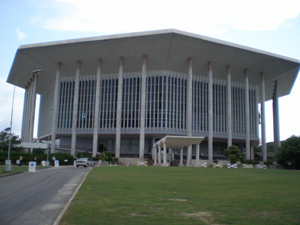 | | 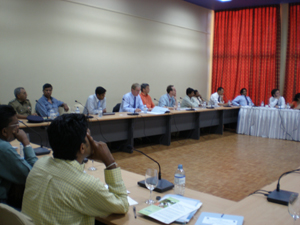 |
| Venue: the Bandernaike Memorial
International Conference Hall, Colombo | |
Participants to the conference were from a wide range of governmental and non-governmental
organizations related to disaster risk reduction. | |
| |
ii. New Master's
Program:
"Disaster Management Policy Program (Water-related Risk Management
Course) " |
| | | |
| To ensure efficiency
in water-related risk management, structural and non-structural measures should
be well-balanced. However, in developing countries where budget and human resources
are limited, the number of experts with advanced knowledge and techniques is limited.
Thus, training is urgently needed for practitioners in this field. For that
purpose, ICHARM will start a new Master's program, "Disaster Management Policy
Program (Water-related Risk Management Course)," from this October in collaboration
with the National Graduate Institute for Policy Studies (GRIPS). The course will
also be conducted in collaboration with a training course, "Training for Expert
on Flood-related Disaster Mitigation," offered by the Japan International Cooperation
Agency (JICA). Both the students of GRIPS and the trainees of JICA will attend
the same lectures together. The ultimate goal of the course is to promote
solutions for water-related disasters in developing | |
countries, and the trainees will be expected to promote projects for flood-related
disasters in their countries with the techniques and knowledge they will learn
in this training course.
The characteristics of the course are as below:
Problem-solving orientedA master's degree to be conferred in a yearPractical
rather then theoretical
The curriculum of the course consists
of lectures, such as "Disaster management Policy," "Integrated Flood Risk Management,"
"Hydraulics," "Hazard Mapping & Evacuation Planning," as well as hands-on training
sessions. In parallel with them, each trainee and student is required to write
a master thesis by next September. The trainees of JICA will be expected also
to promote "capacity development" in their organizations/countries. To this end,
the JICA trainees are to write project proposals for their required theses. |
|
| |
| iii.
Town-Watching Exercise (Kurihashi, Japan; June 5-8, 2007) |
| |
| Town-watching is
a process of realizing disaster management contexts from a view point of different
stakeholders by observing and comparing the scenario in the field. A four days
long town-watching training module was conducted from June 5th, 2007 for the participants
of Disaster Management training course, which has been organizing by Japan International
Cooperation Agency in Osaka. This intensive course was comprised of a) a lecture
on Flood Hazard Mapping by Dr. Osti, Speciality Researcher, b) one day town-watching
exercise in Kurihashi, Saitama Japan, c) information compilation and analysis
by participants and, d) group discussion and group presentation. Dr. Ogawa, Professor
of Fuji-Tokoha University, who is also an expert of Town-watching, guided the
exercise. Kurihashi town was severely flooded during Katheleen typhoon
in 1947 and since then, Kurihashi town office and Japanese Government have been
extensively working to mitigate the risk of any probable flood events in the area.
In addition to the structural measures, flood hazard map and warning systems are
well adopted. Flood hazard maps have been distributed to each household in the
locality, aiming to raise awareness among people and to facilitate safe and smooth
evacuation in the case of emergencies. Participants of | |
Town-watching exercise visited the town office and received briefings on the
issues and current flood preparedness activities. The participants acquired hands-on
experience by walking around the designated places in the city. They observed
the local situation by their own eye, asked questions to the public concerning
their know-how and expectations, observed facilities, accessed critical places
including evacuation centres, checked necessary rules and regulation etc.
All together 9 participants from China, Nepal, Maldives, Peru, Saint Vincent &
the Gredadines and Tonga took part in the exercise. They were divided into 3 small
groups and dispatched to the different locations in the city with facilitators.
They discussed their findings in a group while town watching. Information from
town-watching was later compiled and the major findings were synthesized, which
later presented in a group discussion session. They played proactive role during
the whole tenure and were able to put several genuine comments on the existing
flood hazard maps and its application. It is hoped that the participants acquired
basic knowledge on Flood Hazard Mapping and on overall flood hazard management
that can be used to solve problems in their home countries. |
| | | |
| | | 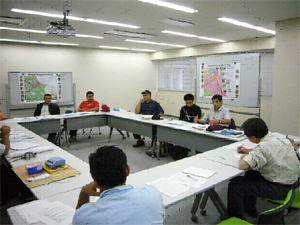 |
| Interview to residents
living in Kurihashi town | |
General discussion | |
| |
| 5.
Attended International Events |
| |
| i.
PIARC Seminar (Cartagena, Colombia; May 3-4, 2007) |
| |
| The International
Seminar on Risk Management for Roads was held by the Risk Management Committee
of the World Road Association
(PIARC). Mr. Terakawa, Deputy Director, participated in the seminar and delivered
the keynote speech in the opening session. He explained integrated flood
risk management for urbanized river basins in Japan with some specific examples.
He also outlined various activities in which ICHARM takes the initiative to contribute
to the prevention and mitigation of water-related disasters throughout the world.
Interestingly, according to the results of the questionnaire survey conducted
by the seminar's secretariat, floods | |
were ranked top as the natural disaster that they most need to address in terms
of risk management for reliable road services.
On the way back home,
Mr. Terakawa visited the US Army Corps of Engineers Institute for Water Resources
(IWR) and exchanged opinions and information with Dr. Eugene Stakhiv, one of the
ICHARM Advisory Board members, on the possible future research collaboration toward
the prevention and mitigation of water-related disasters. ICHARM concluded an
MOU for research collaboration with IWR in July 2006. | | | | |
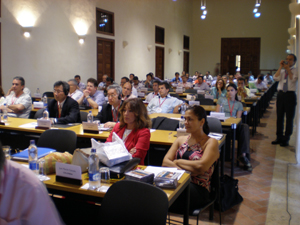 | |
|
| PIARC seminar was
held at the Centro de Formacion de la Cooperation Espanola, Cartagena | |
Dep. Dir. Terakawa visited Dir. Pietrowski (left) and Dr. Stakhiv (right) at
IWR, Washington DC. | |
| |
| ii. UNESCO Trust Fund Review Meeting
(Jakarta, Indonesia; May 23-24, 2007) |
| |
| The review meeting
was held at the UNESCO Jakarta Office to discuss the results and future directions
concerning UNESCO trust fund projects. Dr. Takeuchi, Director, participated in
the meeting as a committee member with Mr. Terakawa, Deputy Director, as an observer,
who introduced the outline of ICHARM and its recent activities at the beginning
| |
of the second day's meeting. The meeting was also a great opportunity to exchange
comments and opinions with officials from both the UNESCO Headquarters and the
Jakarta Office about the multilateral cooperation through the UNESCO-led network,
especially in the Asia-Pacific region. | | | | |
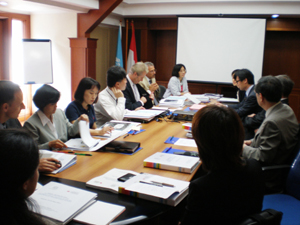 | | 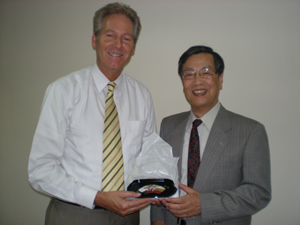 |
| The meeting was held at UNESCO
Jakarta Office. | | Dir.
Gijzen of UNESCO Jakarta Office (left) and Dir. Takeuchi | |
| |
| iii. 1st UNESCO
Water Centers Directors Meeting (Delft, Netherlands; June11-12, 2007) |
| |
| The meeting of the
title was held at IHE immediately prior to the IHE Silver Jubilee Symposium and
Ceremony on 13-15 June 2007. Eleven representatives from UNESCO water centers
including those still in the final stage of official start and more than 20 related
participants such as from UNESCO, WWAP, IWR were gathered. The purpose
of the meeting was to discuss and finalize "the draft strategy for UNESCO's water-related
institutes and centres" produced by the task force met in Geneva on 1-2 February
2007. This was due to mushrooming of a number of category II centers and a need
of collaboration was instructed by Resolution XVII-7 "The development of a strategy
for UNESCO's category I and category II water-related institutes and centres"
adopted by the 17th session of the IHP Intergovernmental Council in July 2006.
The participants were welcomed by the IHE Rector Richard Meganck and IHP
Secretary Andras Szollosi-Nagy opened the meeting. Ms Dalal Alnaggar, Director
of the Regional Centre of Training and Water Studies of Arid and Semi-arid Zones
(RCTWS) in Cairo, Egypt was elected as the Chair. First, all the eleven centers'
directors made a brief introduction of their centers. Then, separating into three
working groups, the themes on Cooperate image, Networking and Evaluation/Reviewing
processes were discussed. | |
In the next day, discussion continued in the plenary on the report of the
separate WGs which lead to a set of agreements of the directors, which include
the follows: | 1) | The
overall mission of UNESCO's water-related institutes and centres is to address
water security and water-related challenges by regional and global action, through
new knowledge, innovative technologies, collaborative interdisciplinary scientific
research, networking, training and capacity development, within the framework
of the IHP. | | 2) | While each category 1 or
2 institute or centre will have continued functional autonomy, it will be part
of a network that would have a recognizable visual identify. | | 3) | While
recognizing diversity, equity and ownership of each water-related institute and
centre, they will work together to contribute to the strategic programme objectives
of UNESCO and its IHP as well as WWAP, through maximizing the level of cooperation
and the synergy among them. | | 4) | It is imperative
that a means of assessing and evaluating the performance of centres be established
to determine whether centres are meeting the expectations of the IHP Intergovernmental
Council and contributing to UNESCO's strategic programme objectives and the needs
of the host government. | | | | | |
|
| |
| iv.
UNESCO-IHE 50th Anniversary Symposium (Delft, Netherlands; June 13-15, 2007) |
| |
| Mr. Terakawa, Deputy
Director, participated in the three-day international symposium entitled "Water
for a Changing World - Enhancing Local Knowledge and Capacity," hosted by UNESCO-IHE
as part of its 50th anniversary this year. UNESCO-IHE is one of the 12 UNESCO-IHP
centers located in different parts of the world and plays a key role in human
resource development in water-related fields. The symposium provided a great opportunity
for a broad range of professionals | |
in water-related fields to exchange ideas and opinions regarding human resource
development to solve global water issues. During the 50th anniversary celebration
ceremony held on the last day, Prof. Alaerts of IHE summarized the outline of
the Symposium, and His Royal Highness the Prince of Orange, Chair of the UN Secretary-General's
Advisory Board on Water and Sanitation, delivered a speech highlighting the importance
of international efforts to solve water issues. | | | | |
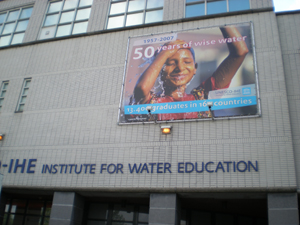 | | 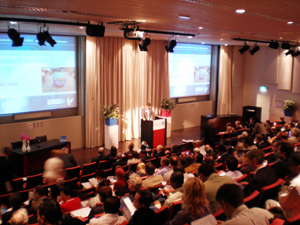 |
| The 50th anniversary poster
of UNESCO-IHE is shown in the signboard of the IHE headquarters entrance. | |
IHE 50th anniversary commemorative symposium was held at the auditorium of
IHE | | | | | 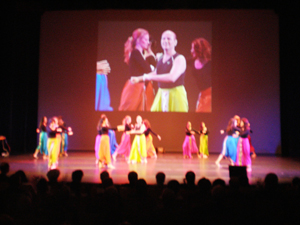 | | |
| Dance performance by professors
and students of IHE at the celebration ceremony at the Theatre de Veste in Delft
City center was highly applauded by the audience. | | |
|
| |
| |
| 6. Coming Events |
| |
|
A new master's program, "Disaster Management Policy Program (Water-Related
Risk Management course)", will start from October 2007 to September 2008 in collaboration
with the National Graduate Institute for Policy Studies (GRIPS). The program will
also be conducted jointly with JICA's training course, "Training for Expert on
Flood-Related Disaster Mitigation". |
| |
|
The 4th "Flood Hazard Mapping" training course will be held from October 28,
2007 to December 1, 2007 in collaboration with JICA. |
| |
|
The Asia-Pacific Water Forum (APWF) will be held at Beppu, Kyusyu, on 3rd -4th
December 2007. ICHARM is designated by the APWF secretariat as the lead organization
of the "Disaster Management" theme. |
| |
| |
|
Information
ICHARM newsletters are distributed via
e-mail. They can also be downloaded from our website. To subscribe or unsubscribe
to our mailinglist, please contact us via e-mail. We welcome any comments or requests
from you to help us make this newsletter more effective and informative.
Issued by: International Centre for Water Hazard and Risk Management
(ICHARM) under the auspices
of UNESCO
1-6 Minamihara, Tsukuba, Ibaraki, 305-8516 Japan
Tel: +81-29-879-6809
Fax: +81-29-879-6709
e-mail: icharm@pwri.go.jp
URL: http://www.icharm.pwri.go.jp/
|


